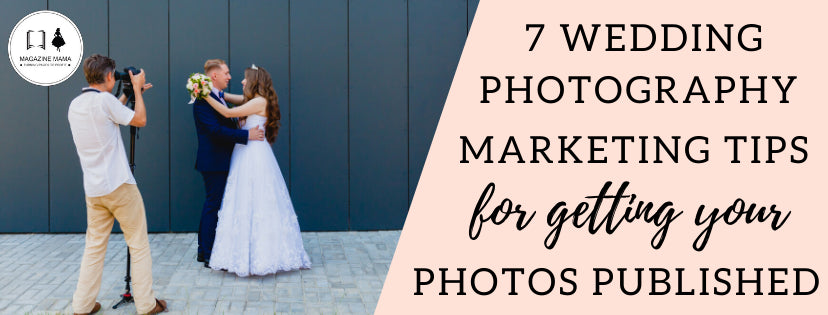Your Cart is Empty


Getting your wedding photography published is a great way to for marketing wedding photography. It brings a level of prestige and can give your wedding photography business the edge among discerning clients. It can also help you stand out among your competition.
Here are a few tips to for getting started.
Local and regional magazines and blogs don’t have the kinds of big budgets national publications do, so you’ll have an easier time getting editorial pick-ups. They are going to be more willing to publish your photos for free, maybe even an article so this is a great place to start.
Many blog and magazines are wary of submissions from vendors, mostly due to potential copyright issues. However, as the wedding photographer you own the images and have shared permissions from your photography, clients making the publishers’ lives easier. So as a photographer you already have an advantage. If you're a wedding vendor reading this, ask your photographer if he or she will submit photos for you.
Wedding websites and magazines need to keep up on the latest trends, and are particularly interested in real wedding submissions. Share amazing, relatable photos and gorgeous detail shots—the shoes, table settings, bouquets. Don’t send black & white. A publisher can easily convert your color shots, but can’t convert back to color.
Speaking of colors, check what the trending wedding pantone colors are of the year and try submitting images with weddings featuring those colors.
The hows of submitting: Most publishers have an email or online submission process, but you should still be mindful of what you’re sending. If it’s a number of huge files, for example, don’t clog up their inbox and, instead, send a customized CD or flash drive. No matter how you submit, make sure everything is labeled, including your name and contact, and that there are no watermarks. And remember, be sure to check any exclusivity clauses and issue close dates.
A writer/photographer is a huge asset for smaller publications. If you can deliver a polished, professional article or blog post to go with your photos, then do it! Also, if there is a unique story behind how the couple met be sure to include it as well.
Try coming in as an advertiser and leveraging your ad dollars for editorial inclusion. I've done this in the past. If there is a bigger package your sales person is trying to sell you on, tell them you'll consider it if you can have one of your weddings featured. You may think it's a lot of money for the ad, but it can pay off in the long run, especially if it's a high end wedding magazine or website that targets your ideal bride and groom.
Since blogs are updated more frequently and need a lot more content, you may have higher chances of getting your photos published online. You can submit your images to sites such as Two Bright Lights and they will connect you with the appropriate publications.
Once you’ve been published, post it to Facebook, Twitter, Pinterest and your blog. Send tabbed copies or emails to those who are in the published photos, including the venue and vendors. For national publications, develop a press release and submit it to local outlets. And be sure to include all published work on your website in a section clearly labeled “PRESS.”
Remember, ask about shared permissions: Let your clients know you’re frequently published, and make sure they’re comfortable with any shared permissions. Most of the time they will be happy to see their photos in print or online and—bonus!—you’ve found a way to tout that you’re an accomplished, published photographer. But respect clients’ wishes not to be published: While copyright laws heavily favor the original creator it’s an emotionally charged issue and you’ll likely wind up with negative reviews or, worse, a lawsuit should photos be published without permission.
Now get shooting—and start submitting!
Wedding Photography Welcome Guide Templates
Wedding Photography Pre-Written Blog Posts
Pre-Written Wedding Photography E-mails

Comments will be approved before showing up.
If you're a photographer launching a 40 Over 40 photography campaign and need ideas for booking more clients, here are 40 marketing ideas to help you promote your campaign with confidence and creativity!